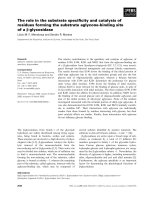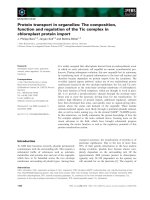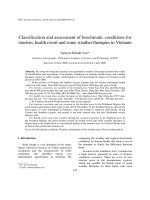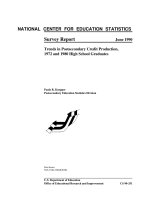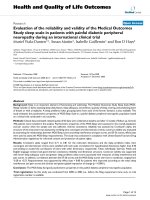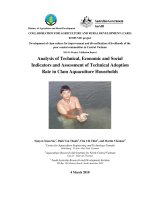REMEDIATION TRENDS IN AN UNDERGRADUATE ANATOMY COURSE AND ASSESSMENT OF AN ANATOMY SUPPLEMENTAL STUDY SKILLS COURSE
Bạn đang xem bản rút gọn của tài liệu. Xem và tải ngay bản đầy đủ của tài liệu tại đây (1.27 MB, 219 trang )
REMEDIATION TRENDS IN AN UNDERGRADUATE ANATOMY COURSE AND
ASSESSMENT OF AN ANATOMY SUPPLEMENTAL STUDY SKILLS COURSE
Audra Faye Schutte
Submitted to the faculty of the University Graduate School
in partial fulfillment of the requirements
for the degree
Doctor of Philosophy
in the Department of Anatomy & Cell Biology,
Indiana University
May 2013
Accepted by the Faculty of Indiana University, in partial
fulfillment of the requirements for the degree of Doctor of Philosophy.
Valerie Dean O’Loughlin, Ph.D., Chair
James J. Brokaw, Ph.D.
Doctoral Committee
David J. Flinders, Ph.D.
January 28, 2013
Anthony L. Mescher, Ph.D.
ii
© 2013
Audra Faye Schutte
ALL RIGHTS RESERVED
iii
Dedication
This dissertation is dedicated to my parents. They have continuously supported
me in my endeavors, always encouraging me to reach for the stars. I cannot fully express
how much love and gratitude I have for them.
This dissertation is also dedicated to my roommate, running partner and best
friend, Sadie. Coming home to a wagging tail never ceases to brighten my day and I
cannot imagine having to complete this process without her.
iv
Acknowledgements
I am so grateful to the many people who have supported me throughout my time
in graduate school. This dissertation definitely would not be what it is today without the
guidance and expertise provided by my advisor, Valerie O’Loughlin. Her continuous
support throughout this process has been invaluable to me.
I would also like to acknowledge my committee members: Tony Mescher, Jim
Brokaw, and Dave Flinders. Your contributions have been paramount to my
development as a researcher and writer.
Jackie Cullison, one of the most helpful people I’ve met! Thank you so much for
your assistance throughout my data collection and analysis. You really are a life saver!
Jenni Keller, developing and teaching M100 with you became more than I could
have imagined. I’m so glad I was able to work on it with you!
My students in M100 and A215, without all of you this entire dissertation would
not be possible. I have learned so much from you all.
I have made so many great friends in my time in Bloomington, and I never
expected such an amazing support system. From the gym to the dog park to campus, I
couldn’t ask for better people to have in my life. I am grateful for the endless
encouragement and wonderful time spent with you all.
IUB medical students who I have been fortunate enough to teach during the past
couple years, thank you for such a wonderful experience. Teaching you has been a
highlight of my graduate career and I’m so happy to now consider many of you to be
friends.
v
Abstract
Audra Faye Schutte
REMEDIATION TRENDS IN AN UNDERGRADUATE ANATOMY COURSE AND
ASSESSMENT OF AN ANATOMY SUPPLEMENTAL STUDY SKILLS COURSE
Anatomy A215: Basic Human Anatomy (Anat A215) is an undergraduate human
anatomy course at Indiana University Bloomington (IUB) that serves as a requirement for
many degree programs at IUB. The difficulty of the course, coupled with pressure to
achieve grades for admittance into specific programs, has resulted in high remediation
rates. In an attempt to help students to improve their study habits and metacognitive skills
Medical Sciences M100: Improving Learning Skills in Anatomy (MSCI M100) was
developed. MSCI M100 is an undergraduate course at IUB which is taught concurrently
with Anat A215, with the hopes of promoting academic success in Anat A215.
This multifaceted study was designed to analyze the factors associated with
students who remediate Anat A215, to predict at-risk students in future semesters, and
assess the effectiveness of MSCI M100. The first facet involved analysis of Anat A215
students’ demographic information and class performance data from the spring semester
of 2004 through the spring semester of 2010. Results of data analysis can be used by
IUB instructors and academic advisors to identify students at risk for remediating, as well
as provide other undergraduate anatomy instructors across the U.S. with potential risk
factors associated with remediation.
The second facet of this research involved analyzing MSCI M100 course
assignments to determine if there are improvements in student study habits and
vi
metacognitive skills. This investigation involved quantitative analysis of study logs and a
learning attitudes survey, as well as a thorough inductive analysis of students’ weekly
journal entries. Lastly, Anat A215 exam scores and final course grades for students who
completed MSCI M100 and students who did not complete MSCI M100 were compared.
Results from these analyses show promising improvements in students’ metacognition
and study habits, but further research will better demonstrate the efficacy of MSCI M100.
Valerie Dean O’Loughlin, Ph.D., Chair
vii
Table of Contents
List of Tables xii
List of Figures xv
Chapter 1: Introduction 1
Success in Anatomy A215 1
Supplemental Instruction & MSCI M100 2
Research Questions 2
Chapter 2: Learning and Metacognition in Anatomy 6
Learning Theories & Anatomy 6
Metacognition 11
Predicting Academic Success 14
Remediation 15
Anatomy Remediation 17
Supplemental Learning Programs 20
Past & Current Anatomy Instruction 25
Anatomy A215 at Indiana University Bloomington 28
Chapter 3: Remediation in Anatomy A215 29
Materials & Methods 30
Results 37
Student Demographics 37
SAT Mean Score Comparisons 39
Anat A215 Exam & Final Course Grades 42
Comparing Remediators 48
viii
Short vs. Long Term Remediators 52
Discussion 55
Chapter 4: Development of a Study Skills Course 62
Backwards Course Design: Creating MSCI M100 63
MSCI M100 Course Assessments 65
Approval Process for MSCI M100 69
Evolution of MSCI M100 70
2010 Summer II Session: A Pilot Study 77
MSCI M100: 2010 Summer Session II Positive Results 77
MSCI M100: 2010 Summer Session II Challenges 80
Future Directions for MSCI M100 82
Chapter 5: Analysis of MSCI M100: Improving Learning Skills in Anatomy 84
Methodology 84
MSCI M100 Metacognitive Self-Assessment Survey 85
Comparison of M100 & Non-M100 Students’ A215 Grades 87
MSCI M100 Study Logs & Blogs 88
Results 92
Survey: Part 1 – Demographic Information 92
Survey: Part 2 – Comfort with the Learning Process & Use of
Learning Tools 95
Study Logs 100
Overall Study Log Trends 104
ix
Grade Comparisons Between MSCI M100 & Non-MSCI M100
Students 104
Comparing MSCI M100 & Anat A215 Final Grades 112
Discussion 114
Survey 114
Study Logs 117
Anat A215 Final Grade & Withdrawal Rate Comparisons 118
Chapter 6: MSCI M100 Blog Analysis 120
Methodology 120
Results 126
Spring 2011 126
Fall 2011 131
Spring 2012 136
Overall Blog Trends 141
Discussion 143
Chapter 7: Conclusions 148
Remediation in Anat A215: Conclusions & Implications 148
Implications for Anatomy Instruction at IU 149
Implications for Academic Advisors 150
MSCI M100 Analysis: Conclusions & Implications 151
Implications for Science Instructors 152
Theoretical Implications 154
Limitations 156
x
Directions for Future Research 157
Remediation in Anatomy A215 157
Study Skills in Anatomy 158
Appendix A: Demographic Characteristics of Anat A215 Students 160
Appendix B: Anat A215 Exam Comparisons: Students who Withdrew versus
Students who Earned a Grade in First Anat A215 Enrollment 162
Appendix C: Independent T-test Results: Exam Comparisons Between Remediators’
Term Enrollment Differences in Anat A215 163
Appendix D: 2010 Summer II Session MSCI M100 Syllabus 166
Appendix E: Spring 2012 MSCI M100 Syllabus 169
Appendix F: MSCI M100 Course Proposal 174
Appendix G: MSCI M100 Sample PBL 179
Appendix H: MSCI M100 Early and Late Semester Surveys 181
Appendix I: Complete Survey Results 191
References 193
Curriculum Vitae
xi
List of Tables
3.1 Indiana University School and Majors of Study 32
3.2 Remediation Variables 35
3.3 Anatomy A215 Student Characteristics from Spring 2004 through Spring
2010 37
3.4 SAT Comparisons between Anat A215 remediators and non-remediators 40
3.5 SAT Scores by Demographic Variable 41
3.6 ANOVA Results: Remediators 1
st
Enrollment versus Non-Remediators Mean
Exam Scores 43
3.7 Paired T-test Results: Remediators 1
st
Enrollment versus 2
nd
Enrollment Mean
Exam Scores 44
3.8 Mean Exam Scores by Demographic Variable 45
3.9 Remediators’ Mean Exam Scores During 1
st
& 2
nd
Anat A215 Enrollment 49
3.10 Comparing Mean Exam Scores of High and Low Achieving Students 51
3.11 Comparison of Remediators’ Final Course Grades during 1
st
and 2
nd
Anat A215
Enrollment 52
3.12 Frequency Distribution of Term Differences Among Anat A215
Remediators 53
4.1 MSCI M100 Learning Goals, Core Competencies and Assessments 65
4.2 MSCI M100 Course Enrollment by Semester: Summer 2010-Spring 2012 71
5.1 MSCI M100 Course Assignments 89
5.2 MSCI M100 Spring 2012 Survey Results: Part 1 93
5.3 Comparison of Early and Late Semester Comfort Levels 96
xii
5.4 Comparison of Early and Late Semester Use of Learning Resources 98
5.5 Mean Survey Responses of Students Who Completed Both the Early and Late
Semester Surveys 99
5.6 Spring 2011 Study Logs: Mean Percentage of Time at Each Productivity Rating
per Exam 101
5.7 Fall 2011 Study Logs: Mean Percentage of Time at Each Productivity Rating
per Exam 102
5.8 Spring 2012 Study Logs: Mean Percentage of Time at Each Productivity Rating
per Exam 103
5.9 Anat A215 Failure and Withdrawal Rates 110
5.10 Comparing MSCI M100 Final Grades to Anat A215 Final Grades 113
6.1 MSCI M100 Blog Codebook 124
6.2 Spring 2011 Blog Topics 127
6.3 Spring 2011 Blog Codes: Study Methods 129
6.4 Spring 2011 Blog Codes: Discussing Time Management 130
6.5 Spring 2011 Blog Codes: Exam 3 Reflection 131
6.6 Fall 2011 Blog Topics 132
6.7 Fall 2011 Blog Codes: Assessing Study Methods 133
6.8 Fall 2011 Blog Codes: Discussing Planning & Time Management 135
6.9 Fall 2011 Blog Codes: Exam Reflection 136
6.10 Spring 2012 Blog Topics 137
6.11 Spring 2012 Blog Codes: Assessing Study Methods 138
6.12 Spring 2012 Blog Codes: Time Management 139
xiii
6.13 Spring 2012 Blog Codes: Exam Reflection 141
xiv
List of Figures
3.1 Mean Lecture and Lab Exam Scores for Remediators and Non-Remediators 42
3.2 Anat A215 Classes Performance Scores Differ Between Non-remediators and
Remediators’ 1
st
& 2
nd
Enrollment 47
4.1 Modifications to MSCI M100 Course Assessments 72
4.2 Sample Study Log 74
5.1 Blank Study Log 90
5.2 MSCI M100 Student Extracurricular Involvement Early and Late in the Semester 94
5.3 Semester Comparisons of Productivity Ratings for Anat A215 Exam Studying 104
5.4 Comparison of Spring 2011 Anat A215 Final Grade Distributions 106
5.5 Comparison of Fall 2011 Anat A215 Final Grade Distributions 107
5.6 Comparison of Spring 2012 Anat A215 Final Grade Distributions 109
5.7 Anat A215 Final Course Grades of Students who withdrew from MSCI M100 111
xv
Chapter 1: Introduction
While students typically strive to do well in undergraduate coursework, some
classes may be more challenging than others for students. Certain courses also cause
additional stress because they are prerequisite for admission into professional programs.
This dissertation examines one of these challenging courses in the hopes of improving
student success rates.
Success in Anatomy A215
Academic success in anatomy and physiology is crucial for undergraduate
students interested in health care professions. Acceptance into health care professional
programs is partly dependent on successful student performance in these courses.
Students must develop an adequate understanding of the structures of the body and how
they function in order to succeed in their chosen field. Inadequate study habits, poor
initial preparation, and a lack of confidence in one’s abilities are important indicators of
students at high risk of performing poorly in undergraduate coursework (Scalise,
Besterfield-Sacre, Shuman, & Wolfe, 2000a).
Anatomy A215: Basic Human Anatomy (Anat A215) is an undergraduate human
anatomy course at Indiana University Bloomington (IUB) that serves as a requirement or
prerequisite for many degree programs at IUB. It is a large (400+ enrollment) lecture
course which includes a laboratory component that is taught by graduate or medical
student associate instructors. The course is composed largely of pre-nursing and pre-
allied health students. The course covers a vast amount of complex material, increasing
the difficulty of the course. The difficulty of the course, coupled with pressure to achieve
grades for admittance into specific programs, has resulted in a withdrawal rate between
1
8% and 13% (O'Loughlin, 2002). Thus, a portion of each class contains students
remediating the course because the student previously withdrew or did not obtain the
desired/required grade in an earlier semester.
Supplemental Instruction & MSCI 100
Anatomy and other science courses are considered to be particularly challenging,
and this has led some instructors to develop supplemental instruction (Arendale, 1994;
Belzer, Miller, & Shoemake, 2003; Blanc & Martin, 1994; Bronstein, 2008; Hopper,
2011; Sawyer, Sylvestre, Girard, & Snow, 1996). Supplemental instruction (SI) allows
students to not only receive help with course material, but they are also taught study skills
as they relate to the material being covered (Blanc & Martin, 1994).
Medical Sciences M100: Improving Learning Skills in Anatomy (MSCI M100) is
an undergraduate course at Indiana University Bloomington that serves as a supplement
to Anat A215. This course was developed in 2012 by two graduate students, including
the author (Audra Schutte), with the goal of helping students (especially those
remediating Anat A215) improve their study habits and metacognitive skills. Enrollment
in MSCI M100 is voluntary, and this course is taught in conjunction with Anat A215,
with the hopes of promoting academic success in Anat A215.
Research Questions
In an attempt to analyze the factors associated with students who remediate Anat
A215, which could then be used to predict at-risk students in future semesters, and assess
the effectiveness of an anatomy study skills course, the following multi-faceted
dissertation research was conducted. The first facet of this research involved analysis of
Anat A215 students’ demographic information and class performance data from the
2
spring semester of 2004 through the spring semester of 2010. These data included age,
gender, ethnicity, major of study, SAT and ACT scores, A215 lab and lecture exam
scores, A215 total points earned (and letter grade received), the number of times an
individual took Anatomy A215. For the purposes of this research, students were referred
to as remediators or non-remediators. Remediators are students who have been enrolled
in Anat A215 two or more times, including those students who withdrew after the first
full week of the semester, and non-remediators are those who have only been enrolled in
Anat A215 once during the study timeframe. Analysis of these data will potentially aid
the IUB instructors in identifying students at risk for remediating and providing those
students with necessary assistance to succeed in Anat A215. The first part of this
research addresses the following questions:
• Are there particular majors or programs whose students are more likely to
remediate Anat A215?
• Is there a gender bias for individuals who remediate Anat A215?
• Are students of certain age groups at greater risk for remediating Anat
A215?
• Are students of certain ethnic backgrounds more likely to remediate Anat
A215?
• How do remediating students’ exam scores and final course grades
compare to students who successfully completed anatomy without
remediation?
• How do remediating students’ exam scores and final course grades
compare to their scores and final grade after the first time in Anat A215?
3
• Do remediating students have lower SAT scores than non-remediating
students?
• Is the length of time between the first and second time enrolled in Anat
A215 related to success of remediating students?
This data analysis can provide undergraduate anatomy instructors across the U.S. with
valuable information about potential risk factors associated with remediation. Thus,
while the remediation data is specific to anatomy at IUB, the analysis of this data should
yield information useful to multiple undergraduate anatomy courses at other colleges and
universities.
The next facet of this research involved analyzing MSCI M100 course
assessments. Several course assignments were analyzed to measure improvements in
study habits and metacognition. This investigation included an inductive approach,
grounded in the data, to analyze students’ weekly journal entries. Quantitative analysis
was conducted to assess study logs, and to compare Anat A215 exam scores and final
course grades for students who completed MSCI M100 and students who did not
complete MSCI M100. Also analyzed were results of a survey administered to capture
students’ skills and behaviors related to learning before and after completion of MSCI
M100 and Anat A215. These course assignments and results of this survey were analyzed
to address the following questions:
• Do students enrolled in MSCI M100 achieve higher exam scores and final
course grades in Anat A215 than students not enrolled in MSCI M100?
• Do MSCI M100 students demonstrate improved metacognitive awareness
after completion of the course?
4
• Do M100 students’ study habits change throughout and after completion
of the course?
The upcoming chapter discusses the current literature on learning theories,
metacognition, remediation in anatomy and other disciplines, supplemental learning
programs and anatomy instruction at undergraduate and graduate levels. Chapter 3
presents the methodology, results and discussion of the analysis of the factors associated
with students who remediate Anat A215. Chapter 4 discusses the development and pilot
of the supplemental course, MSCI M100. This chapter also includes discussion of how
the course has evolved from the pilot. In chapter 5, the methods, results and discussion
of the analysis of several MSCI M100 course assignments are discussed. Analysis of one
regular course assignment in MSCI M100 was extensive, and warranted discussion in its
own chapter. Therefore, chapter 6 discusses the development of a codebook which was
used to analyze blogs completed by MSCI M100 students. Also described in this chapter
are the results and discussion of this analysis. Finally, chapter 7 discusses overall
conclusions drawn from this research. This includes implications for students,
instructors, and academic advisors, as well as directions for future research.
5
Chapter 2: Learning and Metacognition in Anatomy
How students learn has been explored by numerous researchers, and many
different theories have been developed in an attempt to explain the learning process. This
chapter will begin by describing the general categories of learning theories (sociocultural
and cognitive) and the defining features of these theories. Following this discussion will
be examples of how those theories may be applied to anatomy students. Metacognition,
which is simply defined as how we monitor our own thought processes, is a key aspect of
cognitive learning theories and is a focus of this study (Veenman, Van Hout-Wolters, &
Afflerbach, 2006). Because of the emphasis on metacognition, it will be more thoroughly
discussed than other aspects of cognitive theories.
Following the introduction to theories of learning, the discussion will move into
descriptions of remediation and factors associated with student success in undergraduate
education. Remediation will also be explained in the context in which it often applies to
anatomy education, as this is the way it will be used in the present study. Colleges and
universities have implemented a variety of resources and programs to add students who
are struggling, and one widely used program is Supplemental Instruction (SI) (Arendale,
1997; Bronstein, 2008). The various components of SI will be described, and this chapter
will end with a discussion of how anatomy is taught at graduate and undergraduate levels.
Learning Theories & Anatomy
Many theories address the wide array of topics associated with learning. Theories
have been generally labeled by their unit of analysis and the issues addressed by the
theory. However, it should be noted that a single theory is not able to include every
possible factor in learning. Learning theories can be broadly categorized as either
6
sociocultural or cognitive theories. Sociocultural learning theorists analyze how an
individual’s interaction with other individuals and their environment impacts the learning
process (John-Steiner & Mahn, 1996; Packer & Goicoechea, 2000; Siegler, DeLoache, &
Eisenberg, 2005). Cognitive learning theorists emphasize the learning process as it occurs
within an individual, how new information is retained and how it relates and shapes prior
knowledge (Shuell, 1986; Siegler et al., 2005; Terrell, 2006). Each theory type
emphasizes important components of learning; yet no one theory will adequately address
every issue related to learning. Some seem to view cognitive and sociocultural theories
to be in conflict, but perhaps these theories should be considered complements to each
other, as each addresses important aspects not covered by the other.
Sociocultural theorists have examined learners in a variety of communities (in and
out of classrooms), how cultural beliefs and norms affect learning, as well as implications
for teaching and instructional methods (Greeno, 2006; Hodson, 1999; John-Steiner &
Mahn, 1996). The goals of these communities can shape what its members deem to be
important and how its members learn (Roth & Lee, 2004). Communities can also help
instructors to provide context for students. From a sociocultural perspective, one
component of the instructor’s role is to model how to think through such contexts; this
method is referred to as scaffolding (Ge & Land, 2003; Hodson, 1999; Pea, 2004). The
scaffolding method may be described as follows: early on instructors provide more
assistance, but as the semester progresses, students require less and less guidance to
effectively master the subject.
These aspects of sociocultural theories can be seen in an undergraduate anatomy
course. Many undergraduate anatomy students are hoping to pursue a career in an allied
7
health field. These students are often in several classes together, leading to formation of
their own small communities with common interests. Anatomy course material may be
presented in the context as it relates to illnesses or injuries that the students may one day
encounter in their careers or personal lives. Such illnesses and injuries could be used by
the instructor to create opportunities for scaffolding. The instructor can help students
develop critical reasoning skills using their anatomical knowledge to develop differential
diagnoses and explanations for a given diagnosis. The instructor would provide more
structured assistance with such problems in the early part of the semester. As the
semester progressed the instructor’s guidance would be gradually reduced, giving the
students the opportunities to practice using their skills/knowledge.
One of the hallmarks of a cognitive learning theory is its emphasis on the creation
and modification of mental models, or schema, within the individual. These schemata are
key components needed to successfully solve problems (Merrill, 2000; Siegler & Alibali,
2004). This schema may be quite developed or rather limited; either way, it helps
students to encode and make sense of new information (Bruer, 1994; Terrell, 2006). As
information is presented in class, a student’s schema will be embellished and adjusted in
some areas. A task for science educators is not only to help students develop accurate
mental models, but to generate meaningful patterns within those models. Those patterns
help reach a deeper understanding of the material, much like that of experts in the field.
The experts’ deeper, more meaningful and organized schemata allowed them to move
beyond the surface features of the problem and more efficiently utilize deeper features in
reasoning (Bransford, 2000; Bransford et al., 2005; Bybee, 2002).
8
As students process new information, they will likely encounter subject matter
that contradicts one or many of their conceptions already held about the human body.
Misconceptions are often discussed from a cognitive perspective. Students may hold
misconceptions which fall short or even completely fail to accurately explain a given
phenomenon (Bybee, 2002; Posner, Strike, Hewson, & Gertzog, 1982; Smith III, diSessa,
& Roschelle, 1994). Such misconceptions present a challenge to instructors, because
although these conceptions are inaccurate, students hold onto them quite strongly (Bybee,
2002; Savion, 2002; Smith III et al., 1994). One such example comes from the Private
Universe Project in 1989, in which interviews of Harvard graduates and faculty members
demonstrated they held many of the same misconceptions held by children. When asked
to explain why we have seasons, 21 out of 23 interviewees were unable to give an
accurate explanation (Novak, 2002). Despite being highly educated, these people held
onto misconceptions that resulted in them being unable to explain a concept taught in
grade school.
In anatomy, students enter the class with an established schema of the human
body that will be modified and adjusted as the class progresses. However, an anatomy
student, essentially a novice anatomist, lacks the well-developed schema of an expert
anatomist. To better develop students’ novice schemata into a more expert-like schema,
they must make appropriate connections between ideas so that more meaningful patterns
of information emerge (Bransford, 2000). Additionally, students typically have some
preliminary knowledge about the human body and diseases that can afflict it, but there
are often existing misconceptions in this knowledge. For example, most students have
heard of appendicitis and know that it can be quite painful. They also know that the
9
appendix is often removed prior to it rupturing to prevent infection in the individual’s
abdominal cavity. Students conceive that an organ (the appendix) that can be so
problematic must be large. When they see the appendix for the first time they are
surprised to see such a tiny structure. Another example deals with the oxygen levels of
the blood in arteries and veins and the color coding of blood vessels on models or in
images. Arteries are typically red (indicating high oxygen levels in the blood), while
veins are typically blue (indicating low oxygen levels). It is not unusual for students to
hold the conception that all arteries carry oxygenated blood, while veins carry
deoxygenated blood. This leads them to assume that all red blood vessels are arteries and
all blue vessels are veins. Yet, in the pulmonary circulation, arteries are carrying
deoxygenated blood and colored blue, while veins carry oxygenated blood and colored
red.
Posner, Strike, Hewson and Gertzog (1982) view learning as a process of
conceptual change. They argue that in order to change a person’s misconception, the new
theory must be intelligible and plausible. In the example of the appendix mentioned
above, in addition to showing students an actual appendix, providing an intelligible
reason for its potential to wreak havoc in the abdomen (despite its small stature) can help
students correct their misconceptions. In the blood vessel example, it takes a great deal
of discussion about the function of pulmonary circulation versus systemic circulation to
help students correct the generalized conception(s) they hold about arteries and veins and
how those vessels are shown on models or in images.
10

